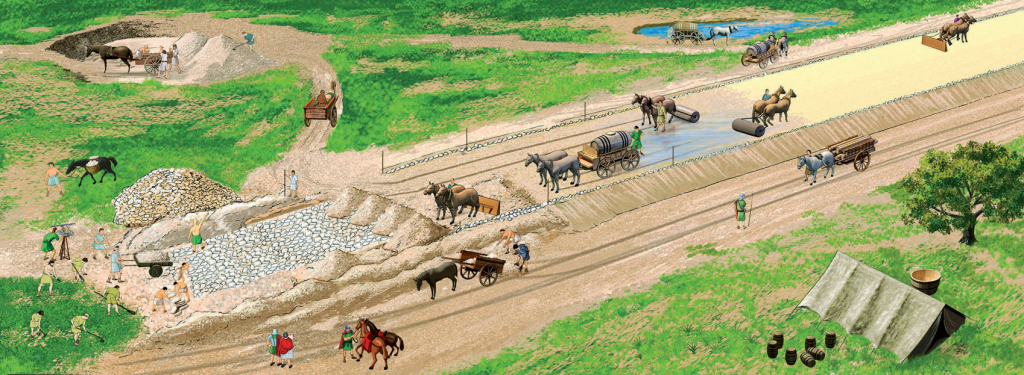How and why?
Roman roads played a vital role in the success achieved by the Roman Empire over more than 4 centuries of history because, thanks to them, its territory was extremely well connected, enabling quick and efficient mobilisation, a constant necessity: military troops, taxes, goods, raw materials, labour, etc. Therefore, their design and construction were the result of thorough planning, which was often accompanied by a detailed study of the terrain.
It should be stressed that the vast majority of interurban roads that formed this dense network of roadways would not have consisted of paved paths. They would have been gravel and crushed stone paths that required less maintenance, making them a cheaper and more efficient alternative. Ignorance of this factor has led to these types of paths being ignored and other, paved roads being incorrectly dated back to the Roman period.
FOR FURTHER INFORMATION
Conferences on ancient Roman road
Minutes of the Conferences on Ancient Roman Roads held in Auritz-Burguete (Navarra) in 2013 (available on PDF)
Traianvs
A website created by Isaac Moreno Gallo, with a compilation of numerous studies on Roman Roads on the Iberian Peninsula.

THEIR CONSTRUCTION
The construction method was not greatly different to that of modern dirt roads or tracks. Firstly, the road’s route would be planned, following a path with a gradient no greater than 6%. The path was then cleared and, if necessary, the ground would be excavated until a solid base was reached, on which heavy stones would be laid to serve as a foundation. Then, the entire surface would usually be filled with aggregate and smaller stones, so that no gaps remained. Finally, they would usually spread a final top layer or road surface formed by sand, gravel and clay.

Additionally, the road did not use to be completely level, it would be slightly curved in the middle to allow the water to run off to the sides, to avoid any puddles that would damage it. They would also place milestones or signs on the edges, offering road users information about the distances to the nearest settlements or similar.
Therefore, the image of paved paths is incorrect; this was only done in towns because, among other things, the animals did not wear horseshoes and their hooves could not withstand the force.
Valuable information about the construction of the roads is also cited in Greek and Latin texts, as can be seen in the following reference that Plutarch made to Gaius Gracchus, a republican politician responsible for the roads.
“He busied himself most earnestly with the construction of roads, combining beauty and utility. For his roads were carried straight through the country without deviation, and had pavements of quarried stone, reinforced with tight-rammed masses of sand or gravel. Depressions were filled up, all intersecting torrents or ravines were bridged over, and both sides of the roads were of equal and corresponding height so that the work had everywhere an even and beautiful appearance.
In addition to all this, he measured off every road by miles (the Roman mile was approximately eight furlongs) and planted stone pillars in the ground to serve as signs for travellers. Other stones, too, he placed at smaller intervals from one another on both sides of the road, in order that equestrians might be able to mount their horses from them and have no need of assistance”. (Plutarch, 1979: 153).
Source: Plutarco, 1979, Vidas paralelas, Cayo Graco, 7, Madrid, Ed. Iberia, volume 4, p. 153 based on the translation of the Greek version by A. Ranz Romanillos.

